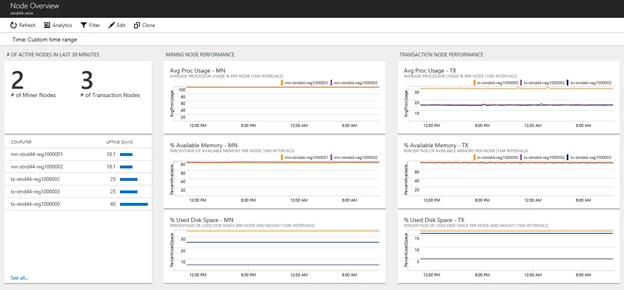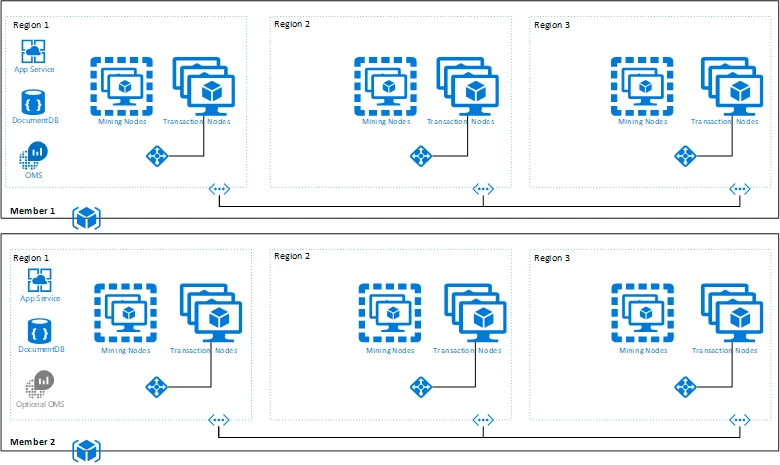Announcements, Azure confidential ledger, Databases
Improved multi-member Blockchain networks now available on Azure
Posted on
2 min read
We see strong customer interest in the Blockchain solutions that are available on the Azure Marketplace. As customers build production Blockchain scenarios, we understand that network reliability and health monitoring become increasingly important. Today, we are excited to announce significant enhancements to our Ethereum on Azure offering. These improvements are the first of a series of releases designed to enable production-ready consortium Blockchain networks suited for enterprise scenarios.
Through our customer engagements, we have identified and rolled out the following improvements:
- High availability of Blockchain network presence: As a participant on a decentralized network, your nodes’ presence in the consensus process is critical towards achieving a fair and secure network. To ensure high-availability, we’ve incorporated cross-region Azure VM Scale Sets (Azure VMSS) and Azure Managed Disks. In the case that a node goes down, Azure VMSS will automatically recover the node, and join it back to the Ethereum network. As active nodes may change over time, we take care of maintaining an accurate boot-node list, allowing other members to join the network.
- Simplified deployment experience: Choosing the right network topology for your scenario can be difficult. We’ve invested significant effort into consolidating the various Ethereum network topologies into one experience, which allows users to walk through deployment options and only shows the information that is important to your scenario.
- Monitoring and operational support: In the world of DevOps, the Blockchain network cannot be a blind spot within your application architecture. We appreciate the need to monitor, log, and analyze network health and Blockchain metrics. Now we support deployment of a customizable monitoring dashboard together with your Blockchain network to monitor telemetry of your Blockchain infrastructure. Today, you can monitor and create custom alerts on CPU, Memory, and Disk Capacity across your miner and transaction nodes.

Figure 1 OMS monitoring of Ethereum nodes
Our new template can deploy infrastructure for a standalone test network, the creation of a new consortium network, or the addition of a new member to an existing consortium network. Now, a single consortium member has the option to deploy their Blockchain footprint into multiple regions for redundancy and disaster recovery.
These solution templates are designed to make it faster and easier to deploy and configure a multi-member consortium Ethereum network with minimal Azure and Ethereum knowledge. With a handful of user inputs and a single-click deployment, each member can provision their network footprint using Microsoft Azure compute, networking, storage, and other services across the globe. Each member’s network footprint consists of a set of load-balanced transaction nodes with which an application or user can interface with to submit transactions, a set of mining nodes to manage consensus, and a VPN gateway for cross-tenant connectivity. Our deployment guide illustrates how to setup the VPN connection to link the gateways and create a fully configured multi-member Blockchain network.
A multi-member network architecture where each member has deployed to three regions is illustrated below. Each black perimeter below represents a resource group that contains the footprint for one member in the consortium.

Figure 2 Multi-Member Multi-Region Topology
It is important to note that although the template configures hub and spoke connectivity model between members, the consortium can change the connectivity model to fit their specific needs.
For more information about the solution, you can visit our guided walkthrough.
Thank you for your continued enthusiasm and support for our Blockchain offers in Azure. We’re excited to release the enhanced version of these templates and encourage you to transition to this new offering to achieve high-availability and improved monitoring.